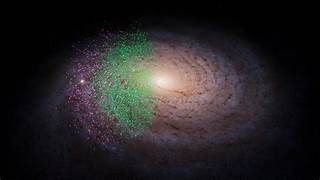Science
Astronomers Uncover Gamma Ray Signals Linked to Dark Matter

Astronomers have discovered significant evidence suggesting that the gamma ray glow from the Milky Way galaxy may be connected to dark matter. A study published on October 15, 2025, in *New Scientist* reveals that the high-energy radiation observed at the galaxy’s center could be produced by dark matter particles interacting in a manner that generates detectable gamma rays. This finding could reshape our understanding of the universe’s composition.
Research has focused on the region surrounding **Sagittarius A***, the supermassive black hole at the heart of the Milky Way. This area has long emitted intense gamma rays, but the new analysis indicates that the glow extends beyond what can be attributed to known sources such as neutron stars or black hole jets. Dr. Michaela Corsini, a lead author of the study, stated, “The data strongly suggests that something else is contributing to the gamma-ray emissions in the galactic center — possibly dark matter particles colliding and releasing bursts of energy in the form of gamma radiation.”
Dark matter, which constitutes approximately **85% of the universe’s total mass**, is invisible to conventional telescopes because it does not emit or absorb light. Theoretical particles known as **WIMPs** (Weakly Interacting Massive Particles) are posited to exist within this mysterious substance. If these particles collide, they may produce gamma rays that instruments like the **Fermi Gamma-ray Space Telescope** can detect.
Revisiting the Fermi Galactic Centre Excess
The phenomenon known as the “**Fermi Galactic Centre Excess**” was first identified over a decade ago when researchers observed an unexplained brightness in gamma-ray maps. Initial theories attributed this glow to pulsars, but the latest analysis incorporates machine learning algorithms and updated cosmic background radiation models. According to the study, the new simulations discount pulsars as the sole cause of the gamma ray emissions.
Instead, the energy spectrum observed aligns with predictions for dark matter annihilation, where pairs of dark matter particles collide and convert their mass into high-energy photons. Dr. Corsini’s team also notes that the gamma-ray glow exhibits a spherically symmetric distribution, a pattern consistent with dark matter rather than localized stellar sources.
Implications for Dark Matter Research
While these findings are intriguing, researchers emphasize that they do not constitute definitive proof of dark matter. Competing hypotheses remain, such as the existence of yet-undetected compact stellar objects. Professor James Walker, an astrophysicist from the **University of Cambridge**, remarked, “This is one of the most promising leads we’ve had in years. But to claim a dark matter detection, we need to rule out every other astrophysical explanation with absolute certainty.”
Future missions, including the **Cherenkov Telescope Array** and the **European Space Agency’s Athena X-ray Observatory**, are anticipated to deliver higher-resolution data that could clarify whether dark matter is indeed responsible for the Milky Way’s gamma ray glow. Understanding the source of this radiation could provide essential insights into how dark matter influences the universe.
If the gamma rays do originate from dark matter interactions, they could help scientists pinpoint the density and behavior of dark matter near the galactic center, bringing researchers closer to identifying its true nature—an elusive goal that has hindered scientific progress for over fifty years.
The study also underscores the importance of multi-wavelength astronomy, which combines data from gamma-ray, X-ray, and infrared telescopes. By mapping these signals, astronomers can identify patterns of invisible matter and potentially detect regions where dark matter density is concentrated. Dr. Corsini and her team aim to incorporate new data from the **European Space Agency’s Gaia mission**, which tracks the movements of over **one billion stars**. This effort may reveal subtle gravitational signatures indicative of dark matter clustering in the vicinity of the galactic core.
As researchers continue to explore these cosmic mysteries, the scientific community is poised for what could be a groundbreaking discovery in modern astrophysics. Should the detection of dark matter via gamma-ray emissions be confirmed, it would not only elucidate the source of the Milky Way galaxy’s gamma ray glow but also fundamentally alter our understanding of the cosmos. Dr. Corsini remarked, “This isn’t just about our galaxy. If we confirm that these signals are coming from dark matter, we’re essentially uncovering the invisible scaffolding of the entire universe.”
The gamma ray glow of the Milky Way galaxy remains a captivating focus for astronomers, with emerging research pointing toward dark matter as a potential source. Although further verification is necessary, this breakthrough strengthens the hypothesis that unseen particles at the galaxy’s core may be responsible for one of the most enigmatic phenomena in the universe.
-

 World5 months ago
World5 months agoSBI Announces QIP Floor Price at ₹811.05 Per Share
-

 Lifestyle5 months ago
Lifestyle5 months agoCept Unveils ₹3.1 Crore Urban Mobility Plan for Sustainable Growth
-

 Science4 months ago
Science4 months agoNew Blood Group Discovered in South Indian Woman at Rotary Centre
-

 World5 months ago
World5 months agoTorrential Rains Cause Flash Flooding in New York and New Jersey
-

 Top Stories5 months ago
Top Stories5 months agoKonkani Cultural Organisation to Host Pearl Jubilee in Abu Dhabi
-

 Sports4 months ago
Sports4 months agoBroad Advocates for Bowling Change Ahead of Final Test Against India
-

 Science5 months ago
Science5 months agoNothing Headphone 1 Review: A Bold Contender in Audio Design
-

 Top Stories5 months ago
Top Stories5 months agoAir India Crash Investigation Highlights Boeing Fuel Switch Concerns
-

 Business5 months ago
Business5 months agoIndian Stock Market Rebounds: Sensex and Nifty Rise After Four-Day Decline
-

 Sports4 months ago
Sports4 months agoCristian Totti Retires at 19: Pressure of Fame Takes Toll
-

 Politics5 months ago
Politics5 months agoAbandoned Doberman Finds New Home After Journey to Prague
-

 Top Stories5 months ago
Top Stories5 months agoPatna Bank Manager Abhishek Varun Found Dead in Well









